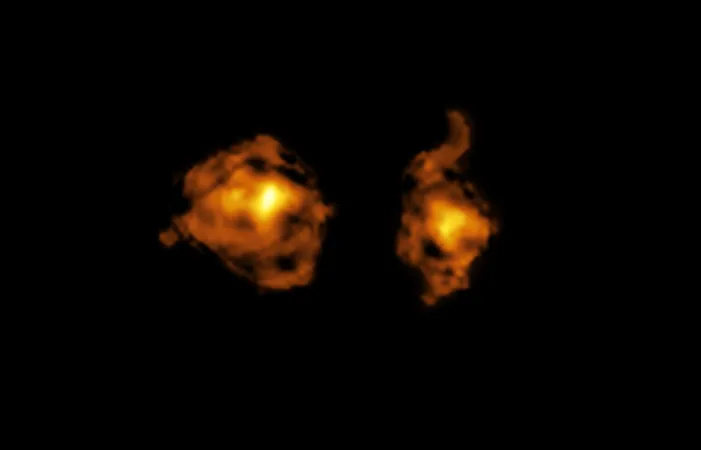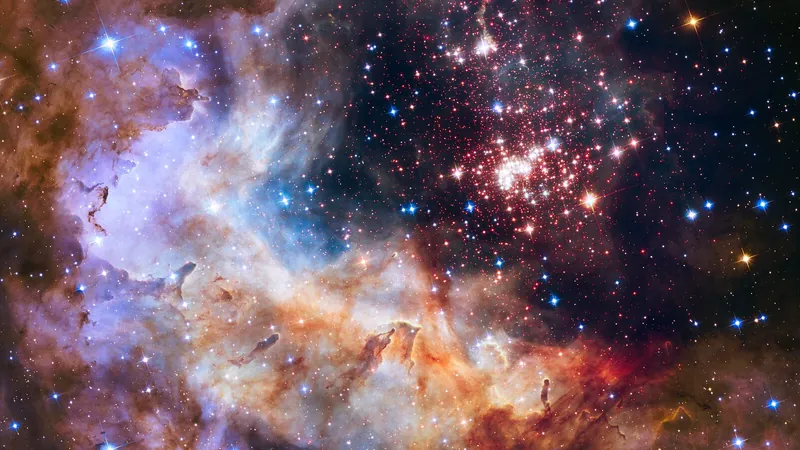
Galactic Gladiators: Astronomers Capture Epic Clash Between Two Distant Galaxies
2025-05-21
Author: Ming
In an astounding cosmic event, astronomers have unveiled the first-ever observation of a cataclysmic collision between two galaxies, unlike anything we've seen before. A riveting study published in Nature reveals that one galaxy is ruthlessly bombarding another with searing radiation, crippling its ability to create new stars.
By harnessing the power of the European Southern Observatory's Very Large Telescope (ESO's VLT) and the Atacama Large Millimeter/submillimeter Array (ALMA), scientists exposed the dramatic nuances of this celestial skirmish.
The Thrilling 'Cosmic Joust' Unveiled
In the far reaches of the cosmos, two galaxies engage in a fierce battle, repeatedly charging at astonishing speeds of 500 km/s, colliding with explosive results before retreating to prepare for another strike. This captivating cosmic dance has been dubbed the 'cosmic joust' by lead researcher Pasquier Noterdaeme, who likens it to the daring competitions of medieval knights. But unlike chivalrous champions, these galactic titans have an unfair edge: one galaxy utilizes a quasar, a brilliant beacon fueled by a supermassive black hole, to launch devastating bursts of radiation.
Witnessing the Past: 11 Billion Light-Years in the Making
The light from this cosmic clash has traveled over 11 billion years through the vastness of space, allowing us to glimpse a time when the universe was just 18% of its current age.
"For the first time, we observe the direct effects of a quasar's radiation on the internal structure of a regular galaxy," explains study co-lead Sergei Balashev, a researcher at the Ioffe Institute in St Petersburg, Russia.
Galaxies Transformed: A Shift in Cosmic Dynamics
The researchers discovered that the relentless radiation from the quasar disrupts the gas and dust clouds of the opposing galaxy, leaving behind only the smallest, densest regions—likely incapable of forming new stars. This dramatic shift spells trouble for the wounded galaxy, which loses its capacity to nurture stellar life.
But the cosmic jouster is not the only one affected. As Balashev notes, such mergers funnel vast quantities of gas into supermassive black holes at the centers of galaxies. This means that while one galaxy suffers, the feeding black hole can sustain its quasar, continuing its havoc.
Next Steps: Unraveling the Mysteries of the Universe
This groundbreaking study was made possible by cutting-edge tools like ALMA and the X-shooter instrument on ESO’s VLT, both located in Chile's Atacama Desert. ALMA's exquisite resolution allowed astronomers to differentiate the two merging galaxies, which previously appeared as one single entity.
With the X-shooter, the team scrutinized how the quasar's light interacted with the regular galaxy, uncovering the devastating impacts of this galactic war.
Looking to the future, astronomers are eager to delve deeper into these cosmic collisions. Noterdaeme emphasizes that the forthcoming Extremely Large Telescope will enhance our ability to explore this phenomenon and others, unearthing further insights into the evolution of quasars and their impacts on surrounding galaxies.





 Brasil (PT)
Brasil (PT)
 Canada (EN)
Canada (EN)
 Chile (ES)
Chile (ES)
 Česko (CS)
Česko (CS)
 대한민국 (KO)
대한민국 (KO)
 España (ES)
España (ES)
 France (FR)
France (FR)
 Hong Kong (EN)
Hong Kong (EN)
 Italia (IT)
Italia (IT)
 日本 (JA)
日本 (JA)
 Magyarország (HU)
Magyarország (HU)
 Norge (NO)
Norge (NO)
 Polska (PL)
Polska (PL)
 Schweiz (DE)
Schweiz (DE)
 Singapore (EN)
Singapore (EN)
 Sverige (SV)
Sverige (SV)
 Suomi (FI)
Suomi (FI)
 Türkiye (TR)
Türkiye (TR)
 الإمارات العربية المتحدة (AR)
الإمارات العربية المتحدة (AR)